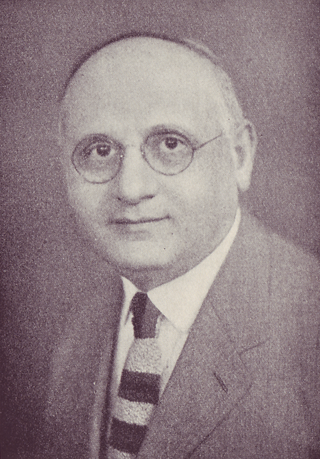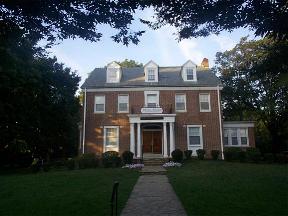Related Research Articles

Cyrus Adler was an American educator, Jewish religious leader and scholar.
Jews in Philadelphia can trace their history back to Colonial America. Jews have lived in Philadelphia since the arrival of William Penn in 1682.
The history of the Jews in Pennsylvania dates back to Colonial America.
Hebrew school is Jewish education focusing on topics of Jewish history, learning the Hebrew language, and finally learning their Torah Portion, in preparation for the ceremony in Judaism of entering adulthood, known as a Bar or Bat Mitzvah. Hebrew School is usually taught in dedicated classrooms at a Synagogue, under the instruction of a Hebrew teacher, and often receives support from the cantor for learning the ancient chanting of their Torah portion, and from the rabbi during their ceremony since they must read from a Torah scroll, which has no Hebrew vowels, and very close together text and minimal line spacing; making it very challenging for almost anyone to read from.

The history of the Jews in Cincinnati occupies a prominent place in the development of Jewish secular and religious life in the United States. Cincinnati is not only the oldest Jewish community west of the Allegheny Mountains but has also been an institutional center of American Reform Judaism for more than a century. The Israelite, the oldest American Jewish newspaper still (2019) being published, began publication in Cincinnati in 1854.
A Jewish day school is a modern Jewish educational institution that is designed to provide children of Jewish parents with both a Jewish and a secular education in one school on a full-time basis. The term "day school" is used to differentiate schools attended during the day from part time weekend schools as well as secular or religious "boarding school" equivalents where the students live full-time as well as study. The substance of the "Jewish" component varies from school to school, community to community, and usually depends on the Jewish denominations of the schools' founders. While some schools may stress Judaism and Torah study others may focus more on Jewish history, Hebrew language, Yiddish language, secular Jewish culture, and Zionism.

Dropsie College for Hebrew and Cognate Learning or Dropsie University, at 2321–2335 N Broad St., Philadelphia, Pennsylvania, was America's first degree-granting institution for post-doctoral Jewish studies. Funded by the will of Moses Aaron Dropsie (1821–1905), it was chartered in 1907, and its first building was completed in 1912. It ceased to grant degrees in 1986.

Isaac Leeser was an American Orthodox Jewish religious leader, teacher, scholar and publisher. He helped found the Jewish press of America, produced the first Jewish translation of the Bible into English, and helped organize various social and educational organizations. He is considered one of the most important nineteenth century American Jewish personalities. He was "fiercely opposed" to Reform Judaism and was regarded as one of the most important "orthodox" rabbis of his era. Leeser is regarded as a forerunner by both Modern Orthodox Judaism and Conservative Judaism.

Congregation Mikveh Israel, "Holy Community Hope of Israel", is a synagogue in Philadelphia, Pennsylvania that traces its history to 1740. Mikveh Israel is a Spanish and Portuguese synagogue that follows the rite of the Amsterdam esnoga. It is the oldest synagogue in Philadelphia, and the longest running in the United States.

Gratz College is a private Jewish college in Melrose Park, Pennsylvania. The college traces its origins to 1856 when banker, philanthropist, and communal leader Hyman Gratz and the Hebrew Education Society of Philadelphia joined to establish a trust to create a Hebrew teachers college. Gratz is a graduate college located in a suburban setting, with fully online courses.

Isaac Husik was a Jewish historian, translator, and student of philosophy, one of the first three individuals to serve as official faculty at Gratz College in Philadelphia.

Sabato Morais was an Italian-American rabbi of Portuguese descent, leader of Mikveh Israel Synagogue in Philadelphia, pioneer of Italian Jewish Studies in America, and founder of the Jewish Theological Seminary, which initially acted as a center of education for Orthodox Rabbis.
Henry Samuel Morais was an American writer and rabbi.

Joseph Krauskopf was a prominent American Jewish rabbi, author, leader of Reform Judaism, founder of the National Farm School, and long-time (1887–1923) rabbi at Reform Congregation Keneseth Israel (KI), the oldest reform synagogue in Philadelphia which under Krauskopf, became the largest reform congregation in the nation.

William Chomsky was an American scholar of the Hebrew language. He was born in the Russian Empire and settled in the United States in 1913.

Mayer Sulzberger was an American judge and Jewish communal leader.

Few Jews arrived in Baltimore, Maryland, in its early years. As an immigrant port of entry and border town between North and South and as a manufacturing center in its own right, Baltimore has been well-positioned to reflect developments in American Jewish life. Yet, the Jewish community of Baltimore has maintained its own distinctive character as well.

Temple Adath Israel of the Main Line is a Conservative synagogue located in Merion, Pennsylvania, in the United States. The synagogue offers religious services, pre-school, Hebrew Sunday school, adult education, and community programming. It was founded in 1946 and moved to its current location in 1953. The congregation serves approximately 800 families. Rabbi Eric Yanoff has served as senior rabbi since 2010.
Moses J. Gries was an American rabbi who mostly ministered in Cleveland, Ohio.
Maimonides College was a Jewish institute of higher education which existed in Philadelphia from 1867 to 1873. It was named for the great mediaeval Jewish philosopher and Torah sage, Maimonides. Although short-lived, it was the first Jewish theological seminary in the United States.
References
- ↑ "History and Mission". Gratz College. Gratz College. Retrieved 10 March 2018.
- ↑ "History and Mission". Gratz College. Gratz College. Retrieved 10 March 2018.
- ↑ Adler, Cyrus; Sulzberger, David. "DROPSIE, MOSES AARON". Jewish Encyclopedia. JewishEncyclopedia.com. Retrieved 10 March 2018.
 This article incorporates text from a publication now in the public domain : Singer, Isidore; et al., eds. (1901–1906). "United States". The Jewish Encyclopedia . New York: Funk & Wagnalls.
This article incorporates text from a publication now in the public domain : Singer, Isidore; et al., eds. (1901–1906). "United States". The Jewish Encyclopedia . New York: Funk & Wagnalls.